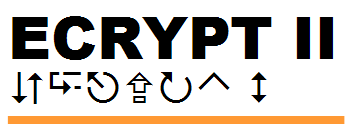NaCl: Networking and Cryptography library

Computer Aided Cryptography Engineering

ECRYPT II
NaCl: Networking and Cryptography library |
 Computer Aided Cryptography Engineering |
 ECRYPT II |
|
Secret-key authenticated encryption: crypto_secretboxC++ interfaceC++ NaCl provides a crypto_secretbox function callable as follows:
#include "crypto_secretbox.h"
std::string k;
std::string n;
std::string m;
std::string c;
c = crypto_secretbox(m,n,k);
The crypto_secretbox function encrypts and authenticates a message m using a secret key k and a nonce n. The crypto_secretbox function returns the resulting ciphertext c. The function raises an exception if k.size() is not crypto_secretbox_KEYBYTES. The function also raises an exception if n.size() is not crypto_secretbox_NONCEBYTES. C++ NaCl also provides a crypto_secretbox_open function callable as follows:
#include "crypto_secretbox.h"
std::string k;
std::string n;
std::string c;
std::string m;
m = crypto_secretbox_open(c,n,k);
The crypto_secretbox_open function verifies and decrypts a ciphertext c using a secret key k and a nonce n. The crypto_secretbox_open function returns the resulting plaintext m. If the ciphertext fails verification, crypto_secretbox_open raises an exception. The function also raises an exception if k.size() is not crypto_secretbox_KEYBYTES, or if n.size() is not crypto_secretbox_NONCEBYTES. C interfaceC NaCl provides a crypto_secretbox function callable as follows:
#include "crypto_secretbox.h"
const unsigned char k[crypto_secretbox_KEYBYTES];
const unsigned char n[crypto_secretbox_NONCEBYTES];
const unsigned char m[...]; unsigned long long mlen;
unsigned char c[...]; unsigned long long clen;
crypto_secretbox(c,m,mlen,n,k);
The crypto_secretbox function encrypts and authenticates a message m[0], m[1], ..., m[mlen-1] using a secret key k[0], ..., k[crypto_secretbox_KEYBYTES-1] and a nonce n[0], n[1], ..., n[crypto_secretbox_NONCEBYTES-1]. The crypto_secretbox function puts the ciphertext into c[0], c[1], ..., c[mlen-1]. It then returns 0. WARNING: Messages in the C NaCl API are 0-padded versions of messages in the C++ NaCl API. Specifically: The caller must ensure, before calling the C NaCl crypto_secretbox function, that the first crypto_secretbox_ZEROBYTES bytes of the message m are all 0. Typical higher-level applications will work with the remaining bytes of the message; note, however, that mlen counts all of the bytes, including the bytes required to be 0. Similarly, ciphertexts in the C NaCl API are 0-padded versions of messages in the C++ NaCl API. Specifically: The crypto_secretbox function ensures that the first crypto_secretbox_BOXZEROBYTES bytes of the ciphertext c are all 0. C NaCl also provides a crypto_secretbox_open function callable as follows:
#include "crypto_secretbox.h"
const unsigned char k[crypto_secretbox_KEYBYTES];
const unsigned char n[crypto_secretbox_NONCEBYTES];
const unsigned char c[...]; unsigned long long clen;
unsigned char m[...];
crypto_secretbox_open(m,c,clen,n,k);
The crypto_secretbox_open function verifies and decrypts a ciphertext c[0], c[1], ..., c[clen-1] using a secret key k[0], k[1], ..., k[crypto_secretbox_KEYBYTES-1] and a nonce n[0], ..., n[crypto_secretbox_NONCEBYTES-1]. The crypto_secretbox_open function puts the plaintext into m[0], m[1], ..., m[clen-1]. It then returns 0. If the ciphertext fails verification, crypto_secretbox_open instead returns -1, possibly after modifying m[0], m[1], etc. The caller must ensure, before calling the crypto_secretbox_open function, that the first crypto_secretbox_BOXZEROBYTES bytes of the ciphertext c are all 0. The crypto_secretbox_open function ensures (in case of success) that the first crypto_secretbox_ZEROBYTES bytes of the plaintext m are all 0. Security modelThe crypto_secretbox function is designed to meet the standard notions of privacy and authenticity for a secret-key authenticated-encryption scheme using nonces. For formal definitions see, e.g., Bellare and Namprempre, "Authenticated encryption: relations among notions and analysis of the generic composition paradigm," Lecture Notes in Computer Science 1976 (2000), 531–545, http://www-cse.ucsd.edu/~mihir/papers/oem.html.Note that the length is not hidden. Note also that it is the caller's responsibility to ensure the uniqueness of nonces—for example, by using nonce 1 for the first message, nonce 2 for the second message, etc. Nonces are long enough that randomly generated nonces have negligible risk of collision. See Validation regarding safe message lengths. Selected primitivecrypto_secretbox is crypto_secretbox_xsalsa20poly1305, a particular combination of Salsa20 and Poly1305 specified in "Cryptography in NaCl". This function is conjectured to meet the standard notions of privacy and authenticity.
Alternate primitivesNaCl supports the following secret-key message-protection functions:
Beware that some of these primitives have 8-byte nonces. For those primitives it is no longer true that randomly generated nonces have negligible risk of collision. Callers who are unable to count 1,2,3,..., and who insist on using these primitives, are advised to use a randomly derived key for each message. VersionThis is version 2019.03.19 of the secretbox.html web page. |